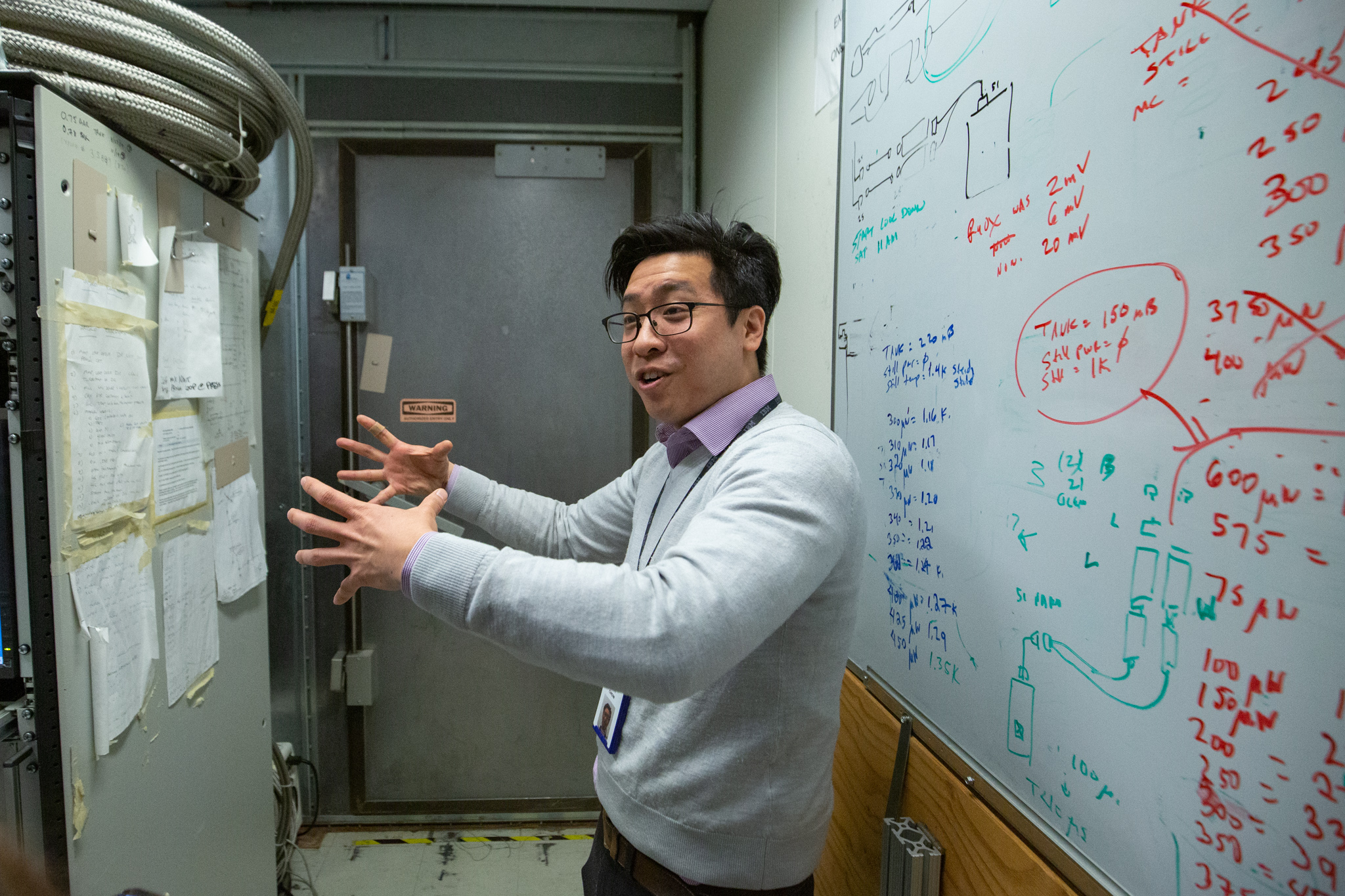
In late March, we toured IBM Research’s HQ in Yorktown Heights, New York, which also houses the majority of the company’s quantum research labs. The lab, which is just about 40 miles north of New York City, is full of oscilloscopes, fridges colder than outer space, tanks of liquid nitrogen, and, of course, quantum chandeliers (more on that in a sec).
A few days ago, we published a profile featuring the director of this lab, Jerry Chow—one of the most important people in quantum computing today. You can read that story here.
Here are some photos that offer a glimpse of what it’s like inside IBM main quantum campus.



Speaking of chips, here are a few early or experimental prototypes of IBM’s quantum-computing processor, housed in museum glass as exhibits of IBM’s history. The one on the left is a three-qubit chip from 2012, and the others have up to eight qubits per chip. They were all made in-house.
Here’s Chow walking down an unassuming hallway in the lab. Some of the hallways are nondescript, like this one, but from time to time, they brought us past labs that look straight out of a sci-fi movie. These rooms run the gamut from testing areas and workshops to a mini chip-fabrication plant.
Speaking of which…


This is an image of IBM’s mini fab, taken through a glass window from the hallway. The reddish-orange glow is caused by UV protection—a hallmark of semiconductor fabrication plants.
Another sight you’re likely to come across if you happen to make it pass the iris-scanners and into IBM’s quantum research facility: people standing on ladders, tinkering with qubit refrigeration systems. Pictured is research staff member Pat Gumann, who is working on a cryogenic system, built in-house, to cool down quantum processors.


Another sight you’re likely to come across if you happen to make it pass the iris-scanners and into IBM’s quantum research facility: people standing on ladders, tinkering with qubit refrigeration systems. Pictured is research staff member Pat Gumann, who is working on a cryogenic system, built in-house, to cool down quantum processors.

Here’s Chow, inside the facility’s oldest and smallest quantum lab. It’s where most of the company’s initial quantum demonstrations happened, which went on to become IBM Quantum as it is today.
Note the high-tech warning to not turn off the computer, scrawled with markers on paper.
Quantum scientists—they’re just like us.



Another sight you’re likely to come across if you happen to make it past the iris-scanners and into IBM’s quantum research facility: people standing on ladders, tinkering with qubit refrigeration systems. Pictured is research staff member Pat Gumann, who is working on a cryogenic system, built in-house, which provides the “cold environment” for quantum processors.

This gold-plated quantum “chandelier” helps keep quantum processors cooled to temperatures near absolute zero so that they can do their jobs. It’s made up of about 2,000 components.
This is a gas-handling system for a dilution refrigerator, which hosts the facility’s quantum processors. It helps adjust the fridge to the correct temperature to give the processors
their best chance at working optimally.

These gloves are used to work on quantum chips in a highly controlled, sanitized environment.
The lab worker puts their hands inside them, flips them inside out, and can then work on the chips inside the glass case.


These spindly gold-tipped wires and the box they’re attached to are the result of an impromptu experiment done in 2011—and one of the quantum lab’s biggest inside jokes.
James Rozen, then a staff engineer on the team, bet his coworkers that surrounding radiation had a negligible effect on a quantum chip’s performance, and to prove it, he encased the quantum chip in a microwave absorber material.
It turned out he was wrong, but in the process, he had discovered an entirely new way to protect quantum chips from noise, leading to a 5x better performance on that metric. In the background, Chow tells us the story behind the keepsake.


There’s also some tech laying around that looks like it belongs more in Xerox’s 1970s-era PARC facility than it does in a 2022 quantum-computing lab. But it’s actually “standard” experimental tech found in the labs—mostly wires, DC control boxes, and multimeters.

This is part of IBM Research’s production development labs, housed inside the larger facility.



In photos:
An inside look at IBM’s quantum computing lab
By: Hayden Field
Photographs by Dianna "Mick" McDougall
May 16, 2022
Dianna "Mick" McDougall
Dianna "Mick" McDougall
Dianna "Mick" McDougall
Dianna "Mick" McDougall
Dianna "Mick" McDougall
Dianna "Mick" McDougall
Dianna "Mick" McDougall
Dianna "Mick" McDougall
Dianna "Mick" McDougall
Dianna "Mick" McDougall
Dianna "Mick" McDougall
Dianna "Mick" McDougall

In photos:
An inside look at IBM’s quantum computing lab
By: Hayden Field
Photographs by Dianna "Mick" McDougall
May 16, 2022
In late March, we toured IBM Research’s HQ in Yorktown Heights, New York, which also houses the majority of the company’s quantum research labs. The lab, which is just about 40 miles north of New York City, is full of oscilloscopes, fridges colder than outer space, tanks of liquid nitrogen, and, of course, quantum chandeliers (more on that in a sec).
A few days ago, we published a profile featuring the director of this lab, Jerry Chow—one of the most important people in quantum computing today. You can read that story here.
Here are some photos that offer a glimpse of what it’s like inside IBM main quantum campus.
Dianna "Mick" McDougall
Dianna "Mick" McDougall
Dianna "Mick" McDougall
Dianna "Mick" McDougall
Dianna "Mick" McDougall
Dianna "Mick" McDougall
Dianna "Mick" McDougall
Dianna "Mick" McDougall
Dianna "Mick" McDougall
Dianna "Mick" McDougall
Dianna "Mick" McDougall